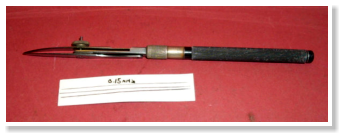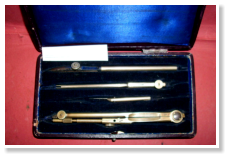









Bowpens & other drawing instruments

Lee Guinness, English bowpen
Late 40's - early 50's

Small Kern Swiss set
1898-1914 vintage

Very early German Riefler set
Pre-1918
Bowpens are the best tools for applying the fine lining to your
locomotive & carriage liveries;- Unfortunately, there are very few quality
instruments available to buy new, & those that are obtainable are rarely
as good as some of the vintage instruments from makers now long
since gone.
Accordingly, we have scoured the world for good quality, vintage
instruments, which we test, expertly regrind, hone & polish where
necessary, & offer for sale on our exhibition stand. We have selections
of both individual bowpens, & quality sets of drawing instruments, which
come in useful for layout planning, scratch building, marking out etc. &
are sold at a small premium above the value of the individual pens
included in them, rather than break up nice sets in their original velvet-
lined cases.
All are graded according to the fineness of the lines they will produce in
neat Humbrol enamel paint, & come with a test card to demonstrate
this, together with a brief instruction sheet giving hints & tips in their use
& care. Stock varies, so it is best to contact us to establish what we
have to suit your needs.
Pen prices range from £15 - £75, Sets from £45 - £195.




A little more about bowpens..
Most of the old instrument manufacturers used to produce 3 different
qualities of instruments. The most basic were intended for students,
with the pen tips made from fairly ordinary steel, often Nickel or chrome
plated. These can occasionally, by careful grinding & polishing, be
made to produce quite fine lines, sometimes down to 0.1mm, but the
points do tend to blunt relatively quickly due to the mildly abrasive
nature of paint pigments. Handles would typically be Brass tube, bone
or plastic.
The next step up in quality was aimed at the general jobbing engineer;-
These were usually made from either high-carbon or chromium steel, &
take a good edge which will last some considerable time. Pens of this
quality will usually draw minimum lines of between 0.06 – 0.08 mm,
once honed & polished. In 4mm scale this would work out at about a
quarter inch or less. Handle material was typically turned Ivory, (for
antique instruments), Bone, Ebony, Aluminium or plastic.
Top quality was aimed at the professional draughtsman and the military,
& are usually the nicest to use. Tips would generally be made of the
highest quality chrome stainless steel, & the best ones can be ground to
produce a minimum line of between 0.04 & 0.06mm. These will be fine
enough to represent the eighth – inch lines used in many lining schemes
on 4mm scale models. They frequently include refinements such as
cross-joints or other features to facilitate easy cleaning, & thumb wheels
marked in increments for accurate adjustment. Handles were invariably
turned, being of Ivory, Ebony, Rosewood, Aircraft-grade Aluminium or
Nickel-silver, depending on era of manufacture. These instruments
should last a lifetime, if properly cared for, & are a joy to use.
Each range would have equivalent ink compasses;- these can be made
similarly fine, & are extremely useful for laying out curves on splashers,
cab openings & wheel-rims. A scrap of ‘plastic card’ can be used to
provide a centre around which to draw the curve.
With practice, these traditional drawing instruments can produce far
superior results to commercially available transfers, & will enable the
modeller to attempt much more ambitious or detailed lining schemes,
such as those of the pre-grouping period.























